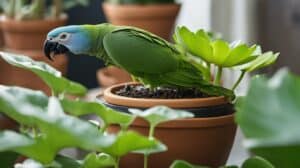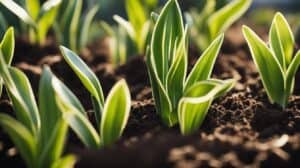The Prayer Plant, also known as Maranta leuconeura, is a popular houseplant that is loved for its unique foliage and ease of care. This plant is native to the tropical regions of Central and South America and is known for its ability to fold its leaves upwards at night, resembling hands folded in prayer. The Prayer Plant is a perfect addition to any home or office space, adding a touch of nature and beauty to any room.

Propagating the Prayer Plant is a great way to expand your plant collection or share this beautiful plant with friends and family. Propagation can be done through stem cuttings or division of the plant, and with the right care and attention, new plants can be grown easily. In this guide, we will explore the different methods of propagating the Prayer Plant and provide tips on how to care for your new plants to ensure their growth and success. Whether you are a seasoned plant parent or a beginner, this guide will help you to successfully propagate and care for your Prayer Plant.
Understanding Maranta Leuconeura
Species Overview
Maranta leuconeura, commonly known as the Prayer Plant, is a tropical plant native to Brazil. It belongs to the Marantaceae family, which includes around 40 species of flowering plants. The Prayer Plant is a popular houseplant due to its unique foliage and ease of care. The leaves of the plant are oval-shaped and have a striking pattern of green and red veins. The plant gets its name from the way its leaves fold together at night, resembling hands in prayer.
Significance of Prayer Plants
The Prayer Plant has significance in various cultures around the world. In Brazil, it is believed to bring good luck and prosperity to homes. In some African countries, the plant is used for medicinal purposes, such as treating fever and stomach ailments. The plant is also known for its air-purifying qualities, making it a popular choice for indoor spaces.
When it comes to propagation, the Prayer Plant is relatively easy to propagate from stem cuttings or division. With proper care and attention, the plant can thrive and continue to bring beauty and significance to any space it occupies.
Propagation Basics

Best Time to Propagate
The best time to propagate Prayer Plant is during the spring and summer months when the plant is actively growing. This is the time when the plant is most likely to produce healthy and strong cuttings that will root quickly. It is important to avoid propagating during the winter months when the plant is dormant, as this can lead to weak and unhealthy cuttings that may not survive.
Tools and Materials Needed
Propagation of Prayer Plant requires a few basic tools and materials. These include:
- Clean, sharp pruning shears
- A clean, sharp knife
- A rooting hormone powder or gel
- A suitable potting mix
- A small container or pot
- A plastic bag or plastic wrap
Before starting the propagation process, it is important to ensure that all tools and materials are clean and sterile. This will help to prevent the spread of disease and ensure that the cuttings have the best chance of success.
Once all the necessary tools and materials are ready, the next step is to select a healthy parent plant and take cuttings.
Step-by-Step Propagation

Propagating a Prayer Plant can be done through two methods: Root Division and Stem Cutting. Both methods are simple and straightforward, and can be done even by novice gardeners.
Root Division Method
The Root Division method is the most common and easiest way to propagate a Prayer Plant. Here are the steps to follow:
- Carefully remove the Prayer Plant from its pot, making sure not to damage the roots.
- Gently separate the roots into two or more sections, making sure each section has healthy roots and leaves.
- Plant each section in separate pots, using well-draining soil.
- Water the newly planted sections and place them in a bright, indirect light.
Stem Cutting Method
The Stem Cutting method is another way to propagate a Prayer Plant. Here are the steps to follow:
- Cut a healthy stem from the parent plant, making sure it has at least two nodes.
- Remove the leaves from the bottom node, leaving only a few at the top.
- Dip the cut end of the stem in rooting hormone, if desired.
- Plant the stem in well-draining soil, making sure the bottom node is buried.
- Water the newly planted stem and place it in a bright, indirect light.
Propagation of a Prayer Plant is a simple and rewarding process that can be done using either the Root Division or Stem Cutting method. By following these steps, gardeners can easily create new Prayer Plants to enjoy in their homes or gardens.
Aftercare and Tips

Initial Care Post-Propagation
Once the prayer plant has been successfully propagated, it is important to provide it with proper care to ensure its survival. The newly propagated plant should be kept in a warm and humid environment to encourage root growth. It is recommended to keep the plant in a plastic bag or under a plastic dome for the first few weeks to maintain high humidity levels.
After the first few weeks, the plant can be gradually introduced to lower humidity levels. The plant should be watered regularly, but not overwatered. Overwatering can lead to root rot, which can be fatal for the plant.
Long-Term Plant Care
The prayer plant is a relatively low-maintenance plant, but there are a few things to keep in mind to ensure its long-term health. The plant should be kept in a bright, but indirect, light to prevent leaf burn. Direct sunlight can cause the leaves to curl and turn brown.
The plant should be watered regularly, but not overwatered. The soil should be kept moist, but not waterlogged. It is recommended to use a well-draining soil mix to prevent waterlogging.
The prayer plant is a tropical plant and thrives in warm and humid conditions. It is recommended to keep the plant in a room with a temperature between 65-75°F (18-24°C) and a humidity level between 40-60%.
Regular fertilization can help promote healthy growth and vibrant foliage. It is recommended to fertilize the plant every 2-3 months during the growing season with a balanced, water-soluble fertilizer.
Overall, with proper care and attention, the prayer plant can provide a beautiful and vibrant addition to any indoor space.
Frequently Asked Questions

How can I propagate a Maranta leuconeura using water?
One way to propagate a Maranta leuconeura, or prayer plant, is by using water. Simply cut a healthy stem with at least two leaves and place it in a glass of water. Change the water every few days to prevent bacteria growth and keep the plant in a bright, indirect light. Once roots have formed, transfer the plant to a pot with well-draining soil.
What is the correct way to propagate a prayer plant from a leaf?
While it is possible to propagate a prayer plant from a leaf, it is not the most reliable method. Choose a healthy leaf and cut it into sections with at least one vein per section. Dip the cut ends in rooting hormone and plant them in a pot with well-draining soil. Keep the soil moist and the plant in a bright, indirect light until new growth appears.
Where should I make the cut for propagating a prayer plant?
When propagating a prayer plant, make the cut just below a node. Nodes are the points on the stem where leaves and roots emerge. Cutting below a node ensures that the plant will have the best chance of developing new roots.
Can you propagate Maranta leuconeura ‘Kerchoveana Variegata’ in the same way as other prayer plants?
Yes, you can propagate Maranta leuconeura ‘Kerchoveana Variegata’ in the same way as other prayer plants. However, keep in mind that variegated plants may be more sensitive to changes in light and humidity.
What’s the best method to encourage a bushier growth in my prayer plant?
To encourage bushier growth in a prayer plant, pinch off the tips of the stems. This will encourage the plant to put out new growth from the sides, resulting in a fuller, bushier plant.
Are coffee grounds beneficial for the growth of prayer plants?
While coffee grounds can be beneficial for some plants, they are not recommended for prayer plants. Prayer plants prefer slightly acidic soil, but coffee grounds can make the soil too acidic and harm the plant.













